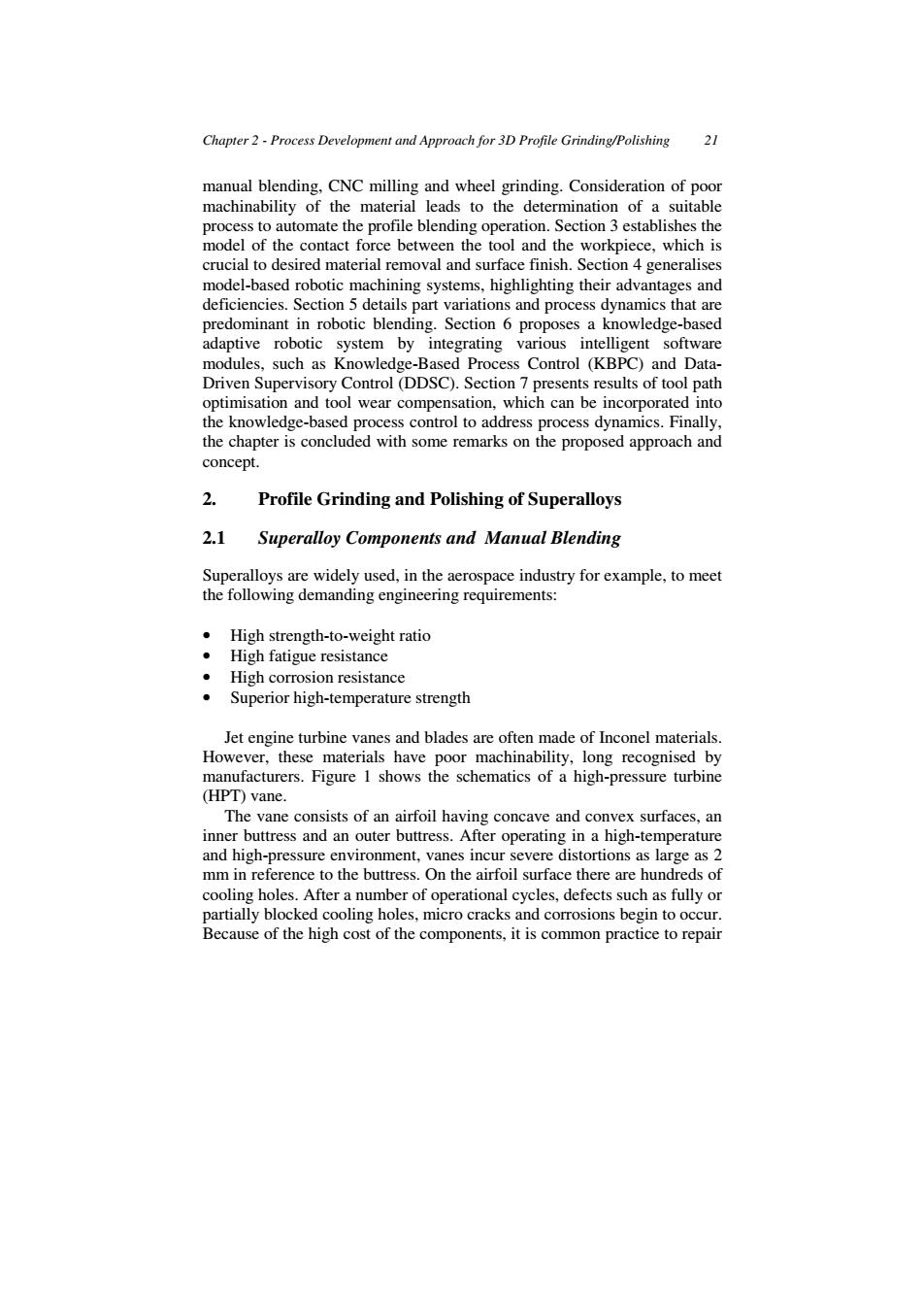正在加载图片...

Chapter 2-Process Development and Approach for 3D Profile Grinding/Polishing 21 manual blending,CNC milling and wheel grinding.Consideration of poor machinability of the material leads to the determination of a suitable process to automate the profile blending operation.Section 3 establishes the model of the contact force between the tool and the workpiece,which is crucial to desired material removal and surface finish.Section 4 generalises model-based robotic machining systems,highlighting their advantages and deficiencies.Section 5 details part variations and process dynamics that are predominant in robotic blending.Section 6 proposes a knowledge-based adaptive robotic system by integrating various intelligent software modules,such as Knowledge-Based Process Control (KBPC)and Data- Driven Supervisory Control(DDSC).Section 7 presents results of tool path optimisation and tool wear compensation,which can be incorporated into the knowledge-based process control to address process dynamics.Finally, the chapter is concluded with some remarks on the proposed approach and concept. 2. Profile Grinding and Polishing of Superalloys 2.1 Superalloy Components and Manual Blending Superalloys are widely used,in the aerospace industry for example,to meet the following demanding engineering requirements: High strength-to-weight ratio High fatigue resistance High corrosion resistance Superior high-temperature strength Jet engine turbine vanes and blades are often made of Inconel materials However,these materials have poor machinability,long recognised by manufacturers.Figure 1 shows the schematics of a high-pressure turbine (HPT)vane. The vane consists of an airfoil having concave and convex surfaces,an inner buttress and an outer buttress.After operating in a high-temperature and high-pressure environment,vanes incur severe distortions as large as 2 mm in reference to the buttress.On the airfoil surface there are hundreds of cooling holes.After a number of operational cycles,defects such as fully or partially blocked cooling holes,micro cracks and corrosions begin to occur. Because of the high cost of the components,it is common practice to repairChapter 2 - Process Development and Approach for 3D Profile Grinding/Polishing 21 manual blending, CNC milling and wheel grinding. Consideration of poor machinability of the material leads to the determination of a suitable process to automate the profile blending operation. Section 3 establishes the model of the contact force between the tool and the workpiece, which is crucial to desired material removal and surface finish. Section 4 generalises model-based robotic machining systems, highlighting their advantages and deficiencies. Section 5 details part variations and process dynamics that are predominant in robotic blending. Section 6 proposes a knowledge-based adaptive robotic system by integrating various intelligent software modules, such as Knowledge-Based Process Control (KBPC) and DataDriven Supervisory Control (DDSC). Section 7 presents results of tool path optimisation and tool wear compensation, which can be incorporated into the knowledge-based process control to address process dynamics. Finally, the chapter is concluded with some remarks on the proposed approach and concept. 2. Profile Grinding and Polishing of Superalloys 2.1 Superalloy Components and Manual Blending Superalloys are widely used, in the aerospace industry for example, to meet the following demanding engineering requirements: • High strength-to-weight ratio • High fatigue resistance • High corrosion resistance • Superior high-temperature strength Jet engine turbine vanes and blades are often made of Inconel materials. However, these materials have poor machinability, long recognised by manufacturers. Figure 1 shows the schematics of a high-pressure turbine (HPT) vane. The vane consists of an airfoil having concave and convex surfaces, an inner buttress and an outer buttress. After operating in a high-temperature and high-pressure environment, vanes incur severe distortions as large as 2 mm in reference to the buttress. On the airfoil surface there are hundreds of cooling holes. After a number of operational cycles, defects such as fully or partially blocked cooling holes, micro cracks and corrosions begin to occur. Because of the high cost of the components, it is common practice to repair